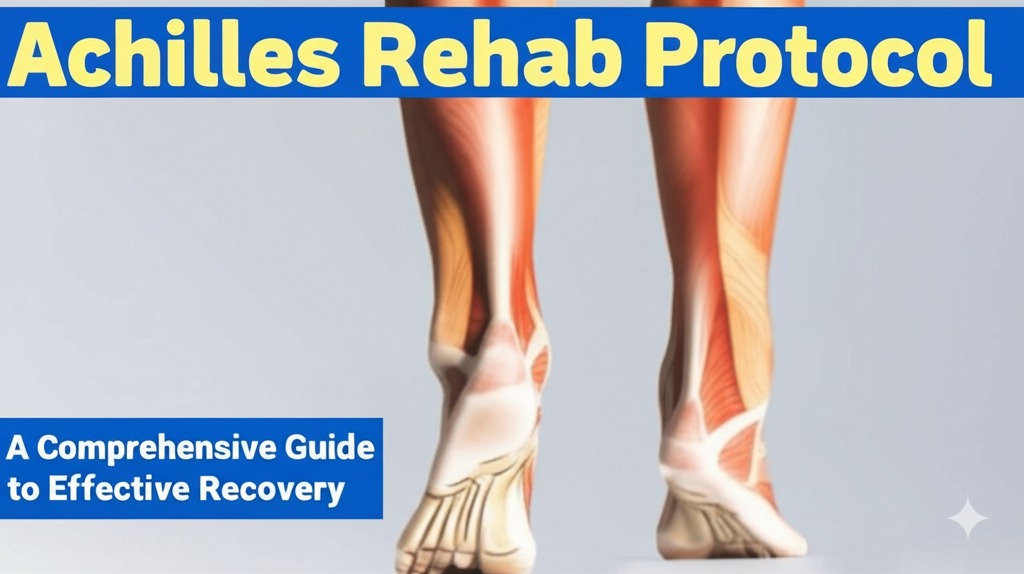The Achilles tendon is one of the most important structures in the lower leg, connecting the calf muscles to the heel. When injured, this tendon can cause significant discomfort and restrict mobility, making recovery a vital process. Whether you’ve experienced a minor strain or a more severe rupture, following the proper Achilles rehab protocol is crucial for returning to normal activities safely and efficiently. In this article, we’ll explore a well-structured and effective rehab protocol that can guide you through your recovery.
Understanding the Achilles Tendon and Common Injuries
The Achilles tendon is the largest and strongest tendon in the body, but it is also susceptible to injury. Common Achilles tendon injuries include:
- Achilles Tendonitis: Inflammation of the tendon often caused by overuse.
- Achilles Tendon Tear or Rupture: A complete tear of the tendon, usually due to sudden force or trauma.
- Achilles Tendonosis: Degeneration of the tendon, typically from repeated strain over time.
Each of these injuries requires a tailored rehabilitation approach to promote healing, reduce pain, and prevent re-injury.
Key Phases of Achilles Rehab Protocol
A successful Achilles rehab protocol consists of several key phases. These phases are designed to ensure gradual recovery while minimizing the risk of further injury. Below, we break down the different stages of rehab.
1. Acute Phase: Rest and Inflammation Control
The first phase of rehab focuses on reducing inflammation and pain. Immediately following an Achilles injury, it’s important to follow the R.I.C.E. method:
- Rest: Avoid activities that aggravate the injury.
- Ice: Apply ice packs for 15-20 minutes at a time to reduce swelling.
- Compression: Use a compression bandage to help manage swelling.
- Elevation: Keep the injured foot elevated above heart level to reduce swelling.
During this phase, the primary goal is to allow the tendon to begin the healing process. This can last anywhere from a few days to a couple of weeks, depending on the severity of the injury.
2. Early Rehabilitation Phase: Gentle Mobility and Strengthening
Once the acute inflammation has subsided, the next step is to gently restore mobility and start strengthening the Achilles tendon. This phase usually begins after the first week of injury.
- Range of Motion Exercises: Focus on gentle stretches and exercises to maintain or restore flexibility in the tendon. Calf stretches and ankle mobility exercises are beneficial.
- Isometric Strengthening: Gentle strengthening exercises like seated calf raises (without weight) can help promote tendon health and begin rebuilding strength.
Avoid any exercises that cause sharp pain or discomfort, and always aim for gradual progress.
3. Intermediate Rehabilitation Phase: Strengthening and Load-Bearing Exercises
This phase is all about gradually increasing the load and intensity on the Achilles tendon. By now, your tendon should have healed enough to handle more stress, but you must still be cautious.
- Eccentric Exercises: These exercises, like lowering your heels slowly during calf raises, are essential for rebuilding strength in the tendon and improving its elasticity.
- Strength Training: Begin to introduce light resistance training for the calves, hamstrings, and quadriceps. This can include using resistance bands or light weights.
- Weight-Bearing Exercises: Incorporate exercises such as walking on a treadmill or cycling to improve cardiovascular fitness without overstressing the tendon.
4. Advanced Rehabilitation Phase: High-Intensity Training and Return to Sport
At this stage, your tendon should be strong enough to handle more dynamic and high-impact activities. This phase focuses on restoring the functionality needed for sports or normal daily activities.
- Plyometric Exercises: Introduce exercises like jump rope, hopping, and jumping drills to challenge the Achilles tendon with quick, explosive movements.
- Agility Training: Practice lateral movements, cutting, and sprinting to mimic the demands of sport and enhance coordination.
- Sports-Specific Drills: Depending on the sport you participate in, incorporate movements like running, change of direction, and sport-specific drills.
The goal during this phase is to prepare the tendon for the demands of your daily routine or sport while continuing to monitor for any discomfort.
Tips for a Successful Achilles Rehab Protocol
To maximize your recovery and reduce the risk of reinjury, consider the following tips:
- Patience is Key: Achilles rehab takes time. Don’t rush the process, and gradually progress to higher-intensity exercises as you feel ready.
- Consistency Matters: Stick to your rehab plan and perform exercises consistently. Missing key steps or skipping rehab can lead to a longer recovery.
- Listen to Your Body: Always monitor your pain levels. If you feel sharp or worsening pain, take a step back and consult with a medical professional.
- Proper Footwear: Wearing shoes with good arch support and cushioning is essential during rehab. Avoid high heels or shoes that put unnecessary strain on the tendon.
- Cross-Training: Engaging in low-impact activities such as swimming or cycling can help maintain overall fitness without stressing the Achilles tendon.
When to Seek Professional Help
While many Achilles injuries can be treated with a structured rehab protocol, there are times when professional intervention may be necessary. If you experience the following, it’s essential to consult with a healthcare provider:
- Severe pain or swelling that doesn’t improve with rest and self-care.
- Difficulty walking or standing for prolonged periods.
- A noticeable limp or inability to move the foot.
- Suspected tendon rupture or tear (often requires surgical intervention).
Conclusion: Your Path to Recovery
Recovering from an Achilles injury requires commitment, patience, and a structured rehab protocol. By following the phases outlined above, you can gradually restore strength, flexibility, and function to the injured tendon. Remember to listen to your body, progress at your own pace, and don’t hesitate to seek professional help when needed.
Taking the first step toward Achilles rehab is the key to returning to your normal activities pain-free. Stay consistent, stay motivated, and your Achilles tendon will thank you for the care and attention you give it!

Kallie Snyder is an author at Stonegate Health Rehab, providing valuable insights, recovery guidance, and rehab resources to help individuals achieve better health and well-being.
